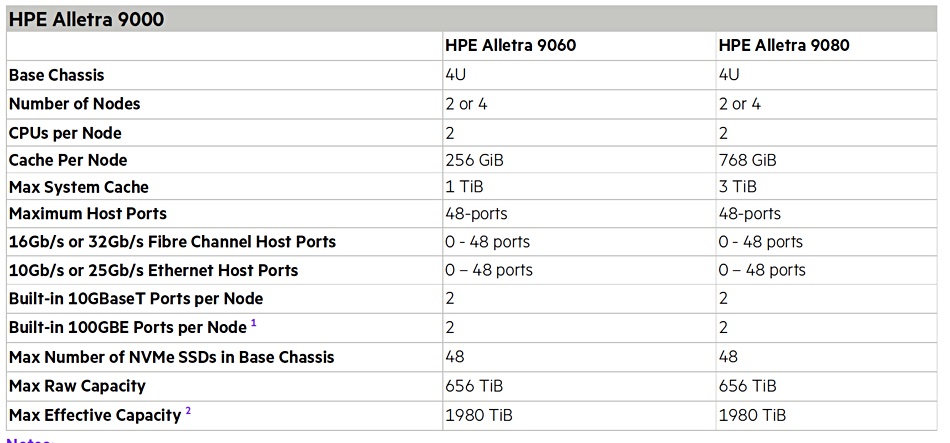Analysis: Datasheet details have emerged about HPE’s brand spanking new Alletra arrays, casting some light on the boxes and their contents but not shining it into every corner.
There are two Alletra all-NVMe flash array variants, the Primera-based 9000 and the Nimble-derived 6000. The hardware differences between the two, in B&F’s view, are such as to make them quite separate products. This is emphasised, in our mind, by the point that there is so far no announced software upgrade path from the 6000 to the 9000.
We found 9000 and 6000 images, bezel-off front images in particular, and the comparison reveals substantial differences between the two products:

Both enclosures are 4U in size. The 6000 has 24 drive slots with the 9000 having 48. The 9000’s drive bays look thinner than those of the 6000, which could be 3.5-inch bays, (which in fact they are, opening up the possibility of future hybrid 6000 arrays.)
At the rear the 9000 has many more IO ports than the 6000 and the cooling fan arrangements are different as well.
The 6000 and 9000 datasheets use different capacity units: TiB for the 9000 and TB for the 6000. This, together with the hardware differences, indicates to us that there are still two separate product groups inside the Alletra organisation.
Alletra 6000
The dual-controller 6000 has up to 24 drives, which can have 1.92, 3.84, 7.68 or 15.36TB individual capacities, with a 368TB maximum capacity listed. The existing Nimble all-flash AF20, AF40, AF60 and AF80 support up to 48 drives in their base enclosure. HPE claims that the Alletra 6000 has up to 3X faster performance than previous Nimble All Flash Arrays, due to using AMD processors and PCIe gen 4 interfaces with an increased lane count.
Controller DRAM scales with the models; 6010 – 64GB, 6030 – 128GB, 6050 – 256GB, 6070 – 448GB, and 6090 – 896GB. Storage class memory is supported as cache by the 6050, 6070 and 6090 arrays.
There are five models in the 6000 family, shown in a specifications table from its datasheet;

There is a scale-out 6090 system, consisting of 4 x 6090 arrays, each with two all-flash shelves. This has a maximum raw capacity of 3.26PB.
The 6000 supports triple parity RAID, and 1, 10, 25 and 100GbitE ports and also 32Gbit/s Fibre Channel. The array port counts shown include both active and standby controllers; active ports are half the value shown.
Alletra 9000
A 9000 datasheet includes a specifications table;

There are two models, the 9060 and the 9080. Both support up to 656TiB (721.3TB) raw capacity from their 48 SFF drives, indicating 15TB SSDs are used. The actual drive capacities are 1.92, 3.84, 7.68 and 15.36TB, and NVMe SFF FIPS encrypted SSD; NVMe SFF SSD; and NVMe SFF FIPS encrypted TAA SSD drive types are supported.
There are up to 48 network interface ports; 10 or 25GbitE , and 16/32Gbit/s FC.
HPE lists the amount of cache per controller node per model, with the 9060 having 256GiB (275GB) and the 9080 given 768GiB (824.6GB). That will help make the 9080 a faster system than the 9060. Both models can have two or four controllers.
The 9000 provides RAID 6 data protection, different from the 6000’s triple parity RAID. We found no mention of storage class memory support in the 9000 datasheet.
We are left with three mysteries:
- Can the 6000 support encrypted drives?
- Does the 6000 have 3.5-inch drive bays and, if so, why?
- Why is there a drive slot type and count difference between the 6000 and 9000?
Update: 6000 and 9000 drive capacity and network port information added, 6 May 2021.
Update: Alletra 6000 PCIe gen 4 and other details added, 7 May 2021.








